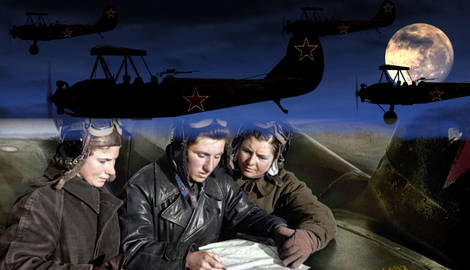
World War II produced many thousands of heroes and renowned combat units. However, one underrepresented group of people in these accolades was women. This underrepresentation was partially because many nations and forces prohibited women from active duty. Despite this, one group of women who shone during this war was the 588th Night Bomber Regiment. This regiment gained notoriety for their stealth, strategy, and success as pilot bombers and was aptly named the Night Witches by their enemies. The Night Witches’ success stemmed from their unique techniques and the leadership that guided and inspired them.
The Red Army in World War II

It can be argued that the Second World War was one of the most significant and devastating conflicts in recorded history. Between 1939 and 1945, the world’s Allied and Axis powers were locked in a battle for dominion over Europe. Starting with the Nazi Germany invasion of Poland on September 1, 1939, the war continued to involve nations from around the globe, including Japan, the United States, and the Soviet Union. Following the invasion, the Soviet Union and its Red Army contributed significantly to the Allies victory in the war, specifically with Operation Bagration, which paved the way for the Allied total success over the Axis powers.
The Soviet Union’s involvement in World War II started in 1939 with the signing of the Molotov-Ribbentrop Pact, which divided Eastern Europe into spheres of influence between the Soviet Union and Nazi Germany. However, in June 1941, Hitler broke the pact and launched a massive invasion of the Soviet Union known as Operation Barbarossa, which quickly turned into a brutal and protracted conflict. Throughout the Second World War, the Soviet Union mobilized millions of soldiers to fight against Nazi Germany and its allies, and the Red Army faced some of the war’s most brutal and devastating battles.

The Soviet Union divided the Red Army into several branches, including tank regiments, aviation regiments, naval infantries, and artillery regiments, all of which were united under the leadership of Joseph Stalin. The aviation regiments within the Red Army were themselves broken up into several squadrons. Bomber squadrons, for example, were responsible for conducting strategic bombing missions against German targets. These units enormously impacted the fight against the Nazis, as they would strategically destroy or damage landmarks and equipment the Germans relied on. While men comprised almost all of these squadrons, one of the most unique bombing squadrons of the Red Army was aptly nicknamed the Night Witches and was made up of an all-woman aviation union.
Women in the Soviet Army during World War II

During the second world war, women were scarce compared to the number of men within the Soviet Forces. While around 800,000 women enlisted in the Red Army during World War II, most took on the responsibility of slowing down German advancements rather than fighting against them. The women would dig tank ditch traps, lay booby traps, and make obstacles with improvised materials. Guerilla groups working to aid Soviet resistance pockets behind enemy lines were also comprised of women who sewed, equipped fighters, cared for the injured, cooked, and smuggled messages. Men, on the other hand, took on almost all of the offensive during this war.
There were, however, special pockets of women fighters in the Red Army who were often overlooked. For example, several Soviet female soldiers are renowned today for their skill and success in World War II. For instance, women snipers in the Red Army proved to be some of the best in the world, with incomparable decision-making and stealth capabilities. However, women soldiers of the Soviet Union have become perhaps most renowned for their unique skills as pilots.
Stealth & Tactics of the Night Witches

The Night Witches, officially known as the 588th Night Bomber Regiment, was a group of all-woman Soviet pilots who flew bombing missions against German forces during the Second World War. These pilots earned their nickname from the Germans, who noted that their Polikarpov Po-2 biplanes sounded like broomsticks. Under cover of darkness, the Night Witches would fly low and slow to drop bombs on enemy targets with remarkable precision. These pilots managed to drop bombs often completely undetected, as they would turn off their engines, allowing them to glide silently over enemy targets. Turning off the engines also made the planes less visible to searchlights, giving the pilots an advantage in evading enemy fire.
The Night Witch’s success was in part due to their stealth tactics. These pilots would fly their Polikarpov Po-2 planes in groups of three. As the women approached their targets, two planes would veer off in different directions. These planes drew the searchlights and flack guns away from the third plane, which would fly alone toward the target. Within the third plane was a navigator who identified when the time was right and a pilot who would turn off her engine after receiving a tap on the shoulder. Then, drifting towards the target silently, the third plane would “woosh” over the target, with the navigator dropping her bombs. This routine continued until all three planes had dropped their loads.

The Night Witches was an extremely successful bombing unit during World War II despite prejudice and a lack of investment from the Soviet Army. For example, the women pilots found it hard to earn respect, were constantly belittled, and were forced to make do with worn-out equipment and uniforms. Moreover, the Witch’s wood-and-canvas planes were generally only used for training or crop dusting, as they were dangerously light, slow, and devoid of protection. Despite this, the Witches used these planes to their advantage as they were quiet and allusive.
The tactics they used awarded the 588th Night Bomber Regiment major success. In their three years of operation, from 1942 to 1945, the regiment logged 28,676 flight hours, dropped over 3,000 tons of bombs and 26,000 incendiary shells, and conducted over 30,000 combat missions. These women also managed to damage or destroy several vital landmarks, including 17 river crossings, nine railways, two railway stations, 26 warehouses, 12 fuel depots, 176 armored cars, 86 prepared firing positions, and 11 searchlights.
One considerable success of the Night Witches was the fear that they were able to strike into the minds of German soldiers. In fact, German soldiers could automatically earn an Iron Cross Medal if they shot down a single Night Witch plane out of the sky. Night Witch pilots were trained to fly in complete darkness and relied on the light of the moon and stars to guide them. This skill fostered rumors that the women had chemicals that gave them cat-like sight at night. The Germans gave the 588th Night Bomber Regiment the derogatory term “Night Witches” because of the whooshing sound the bombing plane would make overhead. However, the regiment readily adopted the term with pride.
The Night Witches: Leaders & Trailblazers

Known by some as the “mother” of the Night Witches, Marina Raskova was the first woman to become a pilot navigator in the Soviet Army. As a personal confidant of Stalin himself, Raskova approached the leader in 1941 about creating three all-woman units under her command, which were not allowed at the time. What motivated Marina were the hundreds of women looking to avenge their brothers, husbands, brothers, and villages that had fallen victim to the German army’s brutality.
Considering the state of the Red Army as well as the fact that she was already a folk heroine due to her brave acts in the 1930s, Raskova was granted allowance and went on to guide these units to many awards and accolades. The formation of these three units, one of which was the 588th regiment, meant that the Soviet Union was the first country to officially deploy female pilots in combat operations.
Unfortunately, Raskova died in June 1943 in a plane crash while attempting to make a forced landing. Raskova received the first Soviet state funeral of World War II. After the war, Raskova became known as the Soviet Amelia Earhart and was honored as one of the Soviet Union’s most accomplished military instructors.

The commander of the 588th Night Bomber Regiment was Major Yevdokiya Bershanskaya. Bershanskaya was one of the few female officers in the Soviet Air Force at the time and played a crucial role in organizing and training the Night Witches. A skilled pilot herself, Bershanskaya had flown in combat during the Spanish Civil War before joining the Soviet Air Force. She was known for her strict discipline and high standards but also for her caring and supportive leadership style.
Under her guidance, the Night Witches became a highly effective and respected unit, earning numerous honors and awards for their service during the war. Bershanskaya remained with the Soviet Air Force after the war, eventually rising to the rank of lieutenant colonel before retiring in 1959. Bershanskaya eventually died of a heart attack in 1982 at the age of 69.

Nadezhda Popova is today also considered one of the most famous Night Witches. Popova was a commander who flew a total of 852 missions, one night flying out 18 times, the record for the 588th Night Bomber Regiment. Likely most famous for her success under fire, Popova returned alive one night after a mission with 42 bullet holes in her plane, her map, and holes in her helmet. Popova is also known for her stories; she passed away in 2013 at the age of 91, which left her many years to recount her adventures.
The Night Witches in Popular Culture

While not widely known, the Night Witches have still managed to make a name for themselves in popular culture. For example, in Sabaton’s Heroes album, a song entitled “Night Witches” details and praises the women from the 588th Night Bomber Regiment. Sabaton, a Swedish heavy metal band, use words such as “flight perfected,” “flawless vision,” and “never miss their mark” to describe the regiment. The Night Witches have also been depicted in several movies over the years, including Night Witches of the Sky (1981) and a series known as Night Swallows (2013).










